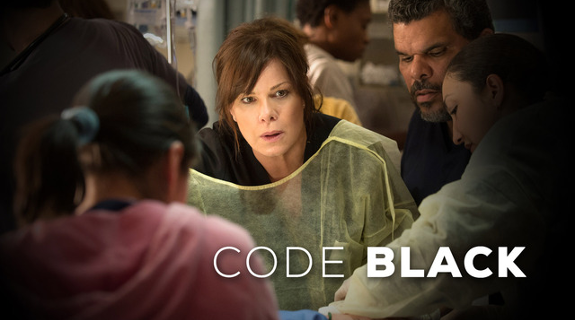On first glance, CBS’ Code Black looks overwhelmingly familiar: another medical drama.
Except this particular medical drama from Executive Producers Michael Seitzman and Ryan McGarry seeks unparalleled realism, and stars Academy Award-winning actress Marcia Gay Harden alongside a diverse ensemble that includes Luis Guzmán, Raza Jaffrey and Bonnie Somerville.
Self-described “obsessed fan” and moderator Brad Bessey (Entertainment Tonight) introduced the panelists as “your Emmy class of 2016.” He likened the pilot to Hill Street Blues, with Code Black as its gritty realist medical counterpart.
This authenticity comes from the source material, as Code Black is based on the critically lauded documentary of the same name.
“It’s the most detailed set I’ve ever been on,” said Jaffrey. “The hospital is a real character. There’s always something to discover.”
“I don’t feel like I’m going to work on a TV show. I feel like I’m going in to do a shift,” said Guzmán. “We all take to heart how much we want to convey that world.”
The word of the day is commitment, with everyone on set fully dedicated to the task at hand: to thrust the audience in the middle of LA County Hospital.
“That kind of visceral feeling you get in the middle of split second life or death decisions, how do you make viewers feel that? We want you to be a participant in the middle of the action in a trauma room,” said Seitzman.
Jaffrey likens the documentary-like shooting experience to the stage. “They don’t clear audio for line. They don’t clear the shot,” Jaffrey said. “You never know when the camera is on you. You can’t hide, and you don’t want to.”
“It’s not about lighting. You don’t even know when it’s your close up. It’s about the material,” said Chandra. “We don’t care what we look like. We just care about telling the story.”
There is a “commitment to writing the truth,” said Young. “No other show has that amount of commitment.”
Each actor goes through Boot Camp and is given a glossary of terminology to study. They were also tasked with learning a list of basic ER procedures: how to place a central line, how to perform a thoracotomy, etc. The cast shadowed doctors at ERs.
Extras are taught about their particular ailment, which must be quite the job: Code Black averages 800 extras a day, and had 1,500 in the pilot.
The show employs 27 trauma nurses and 5 ER doctors, all Taft-Hartley’d into SAG so they can talk on camera.
“They’re essential to us,” Seitzman said. Off screen they act as advisors, and on screen they play nurses and are instructed to “do what you would do” in this situation. “We fit the scene around them.”
Seitzman points out how rare that is in TV, and it’s clear that Code Black is a rare kind of hospital drama, one that everyone seems amazed they can get away with. This isn’t the stylized, loud TV version of a
hospital.
“It’s kind of quiet in the ER; there’s a level of calm about it that’s riveting to be in the midst of. No one’s yelling. It’s a job,” said Harden.
The show is about the “universality of anguish and joy,” Harden said, enthusiastic about playing Dr. Leane Rorish. “She’s a strong woman who doesn’t apologize or explain about being strong - that’s exciting.”
Excitement won’t be a problem for Code Black.
“[The] challenge isn’t how you make it exciting, but how you make it personal,” Seitzman said.
We’ll see how Seitzman, Harden and company rise to the occasion when Code Black premieres Wednesday September 30 at 10/9c on CBS.
Tags:













































__twocolumncontent.jpg)











